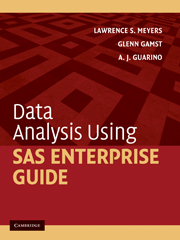Book contents
- Frontmatter
- Contents
- Preface
- Acknowledgments
- I Introducing SAS Enterprise Guide
- II Performing Analyses and Viewing Output
- III Manipulating Data
- IV Describing Data
- V Score Distribution Assumptions
- VI Correlation and Prediction
- VII Comparing Means: The t Test
- VIII Comparing Means: ANOVA
- 23 One-Way Between-Subjects ANOVA
- 24 Two-Way Between-Subjects Design
- 25 One-Way Within-Subjects ANOVA
- 26 Two-Way Mixed ANOVA Design
- IX Nonparametric Procedures
- X Advanced ANOVA Techniques
- XI Analysis of Structure
- References
- Author Index
- Subject Index
25 - One-Way Within-Subjects ANOVA
Published online by Cambridge University Press: 05 June 2012
- Frontmatter
- Contents
- Preface
- Acknowledgments
- I Introducing SAS Enterprise Guide
- II Performing Analyses and Viewing Output
- III Manipulating Data
- IV Describing Data
- V Score Distribution Assumptions
- VI Correlation and Prediction
- VII Comparing Means: The t Test
- VIII Comparing Means: ANOVA
- 23 One-Way Between-Subjects ANOVA
- 24 Two-Way Between-Subjects Design
- 25 One-Way Within-Subjects ANOVA
- 26 Two-Way Mixed ANOVA Design
- IX Nonparametric Procedures
- X Advanced ANOVA Techniques
- XI Analysis of Structure
- References
- Author Index
- Subject Index
Summary
Overview
In a one-way within-subjects design, sometimes referred to as a repeated-measures design, each case is measured on or contributes a data point to every level of the independent variable. Because of this, subjects function in the design as their own controls; this in turn enhances the power of the statistical design. If the drawbacks to this design can be overcome (e.g., carry-over effects; see Gamst et al., 2008), it often becomes the design of choice for a one-way design.
Numerical example
The Automobile Manufacturers Association wished to study the effects of alcohol consumption on driving different types of vehicles. This hypothetical study called for drivers to consume the equivalent of three alcoholic drinks and then drive a complex prescribed closed-track course in one of four kinds of vehicles. Because of the considerable individual differences in drinking and driving that were expected, and because it was believed that the carry-over effects from the different conditions could be largely negated by knowledge of the track, this was designed as a within-subjects study. The organization recruited 14 college students from a local university who were 21 years of age and familiarized them with the track layout. Students were then scheduled for 4 days over the next 2 weeks to drive the course. On each test day, each student was to drive a different vehicle (determined randomly for each student) around the course.
- Type
- Chapter
- Information
- Data Analysis Using SAS Enterprise Guide , pp. 238 - 252Publisher: Cambridge University PressPrint publication year: 2009



